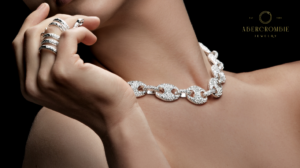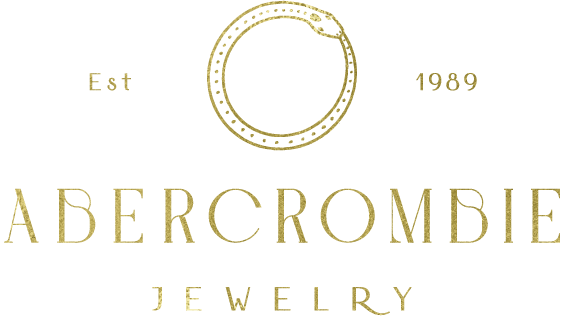- Why Is Estate Jewelry a Sustainable Choice?
- 1. Reuse and Repurpose Existing Jewelry
- 2. Choose Sustainable Repairs and Maintenance
- 3. Purchase from Responsible Sellers
- 4. Educate Yourself on Responsible Sourcing
- 5. Pass Down Estate Jewelry Responsibly
- 6. Reduce Carbon Footprint Through Proper Storage
- The Future of Sustainable Estate Jewelry
- Frequently Asked Questions (FAQs)
Estate jewelry is cherished for its timeless beauty and historical significance and its potential to be a sustainable choice in the modern jewelry market. By extending the life of pre-owned jewelry, we reduce the carbon footprint associated with traditional jewelry manufacturing and mining processes, reduce environmental impact, promote ethical practices, and preserve precious resources.
This guide by Abercrombie Jewelry explores practical steps to make estate jewelry more sustainable, helping buyers, sellers, and collectors contribute to a greener future.
Why Is Estate Jewelry a Sustainable Choice?
Estate jewelry refers to pre-owned pieces passed down or sold, often dating back to specific design eras such as Victorian, Art Deco, or Retro. Unlike new jewelry production, estate pieces reuse existing materials, making them a more environmentally friendly option.
The jewelry industry faces numerous environmental, social, and ethical challenges, including pollution, artisanal mining, and poor working conditions. Estate jewelry addresses these issues by promoting sustainability and ethical choices.
Key Benefits of Estate Jewelry Sustainability:
- Reduces Environmental Impact: Eliminates the need for new mining, which often causes ecological harm.
- Preserve Precious Metals and Gemstones: Allows to reuse gold, platinum, diamonds, and gemstones.
- Ethical Sourcing: Estate jewelry avoids the ethical concerns associated with modern mining and manufacturing practices.
- Timeless Longevity: Quality estate pieces are crafted to last, reducing waste from disposable fashion trends.
Sustainability is not just about buying estate jewelry; it’s about maintaining, reimagining, and responsibly passing it on.




1. Reuse and Repurpose Existing Jewelry
One of the most effective ways to make estate jewelry sustainable is to repurpose and reuse existing pieces. This practice reduces environmental impact. Older jewelry often features exquisite craftsmanship and high-quality materials that can be given new life.
How to Repurpose Estate Jewelry:
Redesign the Piece: Work with a jeweler to transform outdated or damaged jewelry into modern designs. For example, a vintage brooch can become a pendant or ring. Ethical vintage jewelry plays a significant role in sustainable fashion choices, offering eco-conscious consumers a way to make environmentally friendly decisions.
Combine Multiple Items: Merge elements from several pieces to create a unique design.
Replace Loose Stones: Replace missing or damaged gemstones with sustainable alternatives, such as recycled or lab-grown diamonds.
For more detailed tips on transforming old jewelry, check out our guide on How to Sell Vintage Jewelry.
Repurposing ensures that no piece goes to waste while maintaining its sentimental and intrinsic value.
2. Choose Sustainable Repairs and Maintenance
Keeping estate jewelry in good condition helps extend its life and reduces the need for new purchases. Emphasizing sustainable jewelry repair and maintenance practices is essential, as it involves using eco-conscious materials and manufacturing processes. Repairs and regular maintenance are crucial to sustainability.
Tips for Sustainable Repairs:
- Use Recycled Metals: Opt for recycled gold, silver, or platinum for repairs and replacements.
Sustainable jewelry is becoming increasingly important as consumers prioritize eco-conscious choices in their purchasing decisions.
- Repair Instead of Replace: Work with jewelers skilled in restoring estate jewelry to maintain its original features.
- Polish Sparingly: Over-polishing metals can reduce their longevity. Gentle cleaning preserves the integrity of the piece.
- Inspect Regularly: To prevent further damage early, address small issues such as loose stones or weakened clasps.
By investing in repairs, you not only protect the value of estate jewelry but also contribute to reducing waste.
Learn more about proper jewelry care in our comprehensive guide on Estate Jewelry Care: How to Properly Do It.
3. Purchase from Responsible Sellers
When buying estate jewelry, choosing reputable and sustainable sellers is essential. The Responsible Jewellery Council is a key authority in promoting ethical practices and responsible sourcing within the jewelry industry. Look for sellers who prioritize ethical practices and transparency.
What to Look for in a Seller:
Transparency on Provenance: Verify the history and origin of the jewelry to ensure authenticity. Ethical jewelry emphasizes transparency and responsible sourcing, crucial for ensuring worker rights, environmental sustainability, and social equity.
Recycled Materials: Sellers who emphasize recycled metals and stones contribute to sustainability.
Certifications: Work with jewelers or appraisers certified by recognized organizations such as the Gemological Institute of America (GIA).
Responsible sellers help maintain the integrity of the estate jewelry market while encouraging environmentally conscious choices.
4. Educate Yourself on Responsible Sourcing
While estate jewelry is inherently sustainable, understanding how materials were originally sourced adds another layer of ethical awareness. Transparency and traceability in the supply chain ensure that materials are sourced responsibly, support fair labor practices, and avoid conflict involvement. This is especially true for pieces containing gemstones or precious metals.
What to Know About Responsible Sourcing:
- Conflict-Free Stones: Many older estate pieces predate modern regulations, but verifying the origin of diamonds and gemstones is still important.
- Recycled vs. Newly Mined Metals: Estate jewelry often uses recycled metals, reducing reliance on new mining.
- Lab-Grown Alternatives: If a replacement is needed, consider lab-grown diamonds or sustainable gemstones instead of newly mined stones.
- Traditional gold mining has significant negative environmental and health impacts, exposing local communities to toxic chemicals like mercury and cyanide. Sustainable practices and ethical gold sourcing are essential to benefit both miners and the environment.
Educating yourself on these factors ensures you make informed, responsible purchasing decisions.
For insights into evaluating your jewelry’s materials, read Estate Jewelry Appraisal: Determining the Value of Inherited Jewelry.
5. Pass Down Estate Jewelry Responsibly
Estate jewelry is often passed down through generations as cherished heirlooms. Ethical and sustainable jewelry emphasizes the importance of responsible sourcing and environmental stewardship. It ensures that these pieces are created and maintained with care for both people and the planet. To maintain their value and sustainability, it’s essential to care for these pieces and ensure they are responsibly passed on.
How to Pass Down Estate Jewelry:
- Document the Jewelry’s History: Record details such as the era, materials, and significant provenance to preserve its story.
- Keep It Well-Maintained: Ensure pieces are cleaned, repaired, and stored properly.
- Educate Heirs: Teach family members about the value of estate jewelry and the importance of sustainability.
- Resell to Reputable Buyers: If the jewelry will not remain in the family, sell it to trusted buyers who appreciate its historical and environmental value.
By passing down estate jewelry responsibly, you help reduce the demand for newly mined pieces and ensure its legacy lives on.
6. Reduce Carbon Footprint Through Proper Storage
Proper storage is a small but essential way to extend the life of estate jewelry. Storing pieces correctly helps avoid damage and reduces the need for unsustainable repairs or replacements.
Best Practices for Jewelry Storage:
- Use soft, anti-tarnish cloths to wrap fine jewelry.
- Store pieces in a dry, cool environment to prevent tarnishing and oxidation.
- Keep gemstones like diamonds and sapphires separate to avoid scratching softer stones.
- Regularly inspect storage areas for humidity or environmental damage.
Sustainable storage habits ensure estate jewelry remains a valuable and long-lasting option.
The Future of Sustainable Estate Jewelry
Sustainability in estate jewelry goes beyond its beauty. It’s about adopting practices that reduce waste, minimize environmental harm, and honor each piece’s legacy. As consumer awareness grows, estate jewelry offers an ethical and environmentally friendly alternative to newly manufactured jewelry.
Individuals can actively contribute to a more sustainable future by repurposing, repairing, and purchasing estate jewelry responsibly.
Frequently Asked Questions (FAQs)
Estate jewelry is a sustainable choice that blends timeless beauty, history, and ethical responsibility. By maintaining, repurposing, and choosing responsible sellers, you can ensure that these cherished pieces continue to make a positive impact for years. Whether preserving a family heirloom or purchasing a new-to-you treasure, every effort counts toward a more sustainable future.

